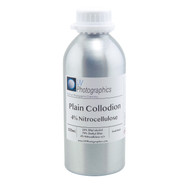Why Collodion Should Not Flow Like Syrup
Posted by Brian Cuyler on May 2nd 2023
The wet plate collodion process was largely forgotten after the introduction of film photography in the early 20th century. However, in the 1990s, a group of photographers, including Mark Osterman, John Coffer, Luther Gerlach, Will Dunniway and Quinn Jacobson revived the process by experimenting with different techniques and formulas based on historical texts. These efforts served as the foundation for many wet plate photographers today. These photographers shared their knowledge and techniques through workshops and publications, bringing renewed attention to the process. Many revived formulas relied on collodion USP, a product designed to attach medical electrodes to skin, which has varying amounts of nitrocellulose and can cause issues for images when the percentage is high. Things such as heavy edges, crepe lines, and wasted collodion are a result of high viscosity collodion.
UV Photographics took what these photographers had done and did further research to optimize collodion formulas and the properties of the collodion itself. Using modern nitrocellulose grades the total nitrocellulose content can be kept the same while reducing the viscosity of the solution. By using a lower viscosity collodion you can avoid issues caused by viscous collodion and create high-quality images that are free from the defects that people have come to believe are inherent to the wet plate collodion process.
Why lower viscosity collodion is desirable.
- Flows better and is easier to coat cleanly, especially when shooting larger plates.
One of the challenges of the wet plate collodion process is coating the plate evenly and cleanly. Using lower viscosity collodion can make it easier to coat larger plates without creating lines or heavy areas. The collodion flows more smoothly and evenly across the plate, allowing for better control of the coating process.
- Leaves the appropriate amount of collodion on the plate, which reduces waste and allows your collodion to go further.
The thinner consistency of the collodion means that you can use less of it to coat a plate and still achieve the desired coverage. A thinker layer of collodion doesn’t improve the image, but it can add undesirable defects.
- Doesn't leave crepe lines in the dried collodion/image.
Crepe lines, seen as wavy parallel lines in the final image can occur when the collodion is too thick or when there is too much water in the collodion. Using lower viscosity collodion can help eliminate crepe lines, resulting in smoother and more even final image.
- Leaves cleaner edges, especially if you blot before it starts to set up.
When the collodion is too thick or unevenly coated, it can create heavy edges or other imperfections around the edges of the plate. Using lower viscosity collodion can help create cleaner edges that are free of imperfections. Blotting the edges of the plate before the lower viscosity collodion starts to set up can also help create cleaner edges.
Using lower viscosity collodion in the wet plate collodion process can offer a range of benefits, from easier coating and reduced waste to cleaner edges and cleaner images. Whether you are new to the process or a seasoned wet plate photographer, it's worth considering the advantages of using lower viscosity collodion to help you achieve the best possible results.

